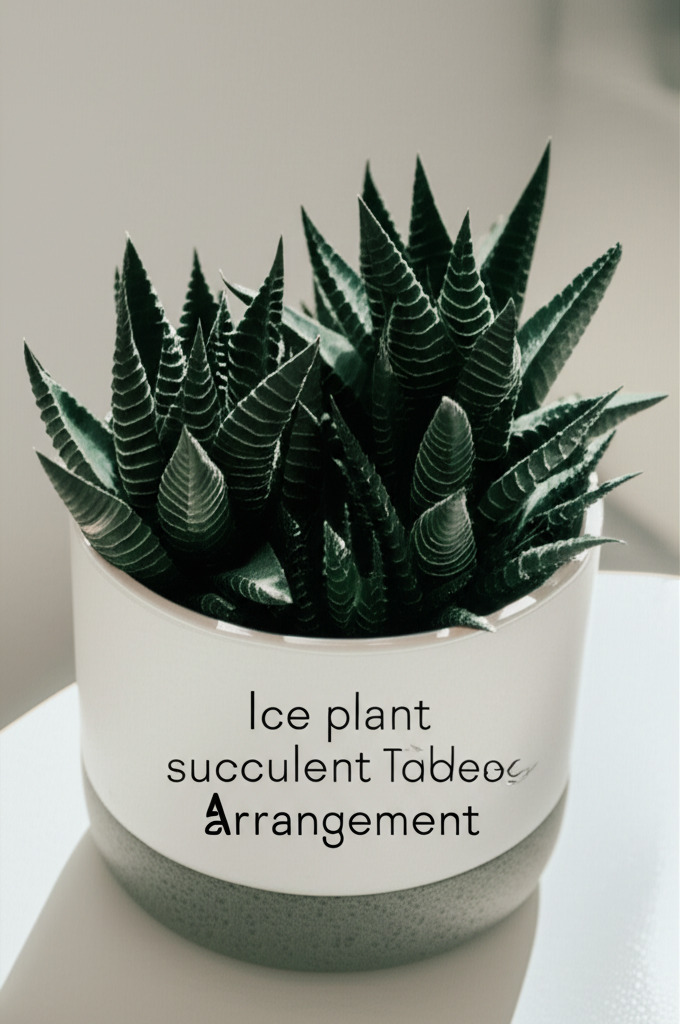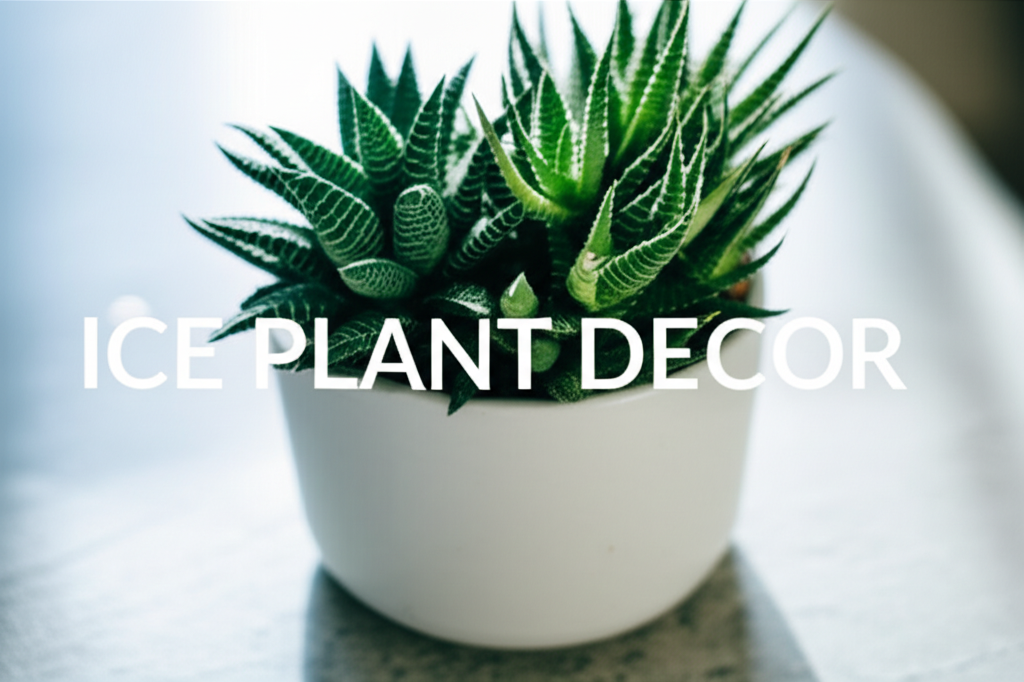Introduction: The Allure of Ice Plants Indoors
The world of indoor gardening offers a delightful escape, and among the most captivating choices are succulents. Specifically, ice plants (family Aizoaceae), with their unique, jewel-like structures and vibrant colors, have surged in popularity for tabletop arrangements. These fascinating plants, often characterized by their hydathodes – specialized cells that store water and give them their characteristic glistening appearance – bring a touch of natural artistry and a splash of invigorating greenery to any indoor space. This guide will delve into the intricacies of creating a stunning and thriving ice plant succulent tabletop arrangement, covering everything from plant selection and container choice to ongoing care and aesthetic considerations.
Understanding Ice Plants: More Than Just a Pretty Face

Before embarking on your arrangement journey, it’s crucial to understand what makes ice plants so special. Native to arid regions of Southern Africa, they have evolved remarkable adaptations to survive harsh conditions. This translates to low-maintenance care indoors, making them ideal for busy individuals or novice plant enthusiasts.
Key Characteristics of Ice Plants:
- Foliage: Their most distinguishing feature is the presence of vesicular epidermal cells, which resemble water droplets or frost, giving them their “ice” moniker. These cells refract light, creating a shimmering effect.
- Growth Habit: Ice plants exhibit a diverse range of growth habits, from compact, low-growing mounds to trailing varieties. This diversity is a significant advantage when planning arrangements.
- Flowering: Many ice plant species produce small, daisy-like flowers that can be incredibly prolific and vibrantly colored, often appearing in shades of pink, red, yellow, and white.
- Water Storage: Like all succulents, ice plants store water in their leaves, stems, and sometimes roots, allowing them to endure periods of drought.
Common Ice Plant Varieties for Tabletop Arrangements:
Not all ice plants are created equal when it comes to indoor tabletop appeal. Some are better suited for their unique textures and compact forms.
- Delosperma (Ice Plant): This genus is perhaps the most well-known. Varieties like Delosperma cooperi are popular for their prolific magenta flowers and trailing habit. Compact cultivars are ideal for smaller arrangements.
- Lithops (Living Stones): While not strictly “ice plants” in the common parlance, Lithops belong to the Aizoaceae family and are prized for their uncanny resemblance to pebbles. Their unusual form makes them a striking addition.
- Conophytum: These miniature succulents are often referred to as “button plants” or “cone plants.” Their compact, rounded bodies and intricate patterns offer incredible visual interest.
- Fenestraria: Known as “window-leaf” succulents, Fenestraria rhopalophylla has translucent tips on its leaf segments that allow light to penetrate to the photosynthetic tissues within.
Key Facts and Comparison of Popular Ice Plant Succulent Varieties
To aid in your selection, here’s a comparative table of some commonly available and suitable ice plant varieties for indoor tabletop arrangements:
| Variety | Common Name | Foliage Appearance | Growth Habit | Flowering | Drought Tolerance | Light Needs | Ideal For |
|---|---|---|---|---|---|---|---|
| Delosperma cooperi | Hardy Ice Plant | Green, slightly bumpy leaves; prominent vesicular cells | Spreading/Trailing | Abundant magenta flowers | High | Full Sun to Partial Shade | Cascading arrangements, mixed containers |
| Lithops spp. | Living Stones | Thick, fused leaf pairs resembling stones; varied patterns | Very Compact, solitary or clumping | Small, daisy-like flowers (various colors) | Very High | Bright, direct sunlight | Minimalist, focal point arrangements |
| Conophytum spp. | Cone/Button Plants | Small, globular or flattened leaf bodies; diverse textures and colors | Clumping, slow-growing | Tiny, often star-shaped flowers | High | Bright indirect light to partial sun | Miniature gardens, close-up arrangements |
| Fenestraria rhopalophylla | Window-Leaf Succulent | Cylindrical leaves with translucent “windows” at tips | Clumping, short stems | White, daisy-like flowers | High | Bright indirect light | Adds unique texture to arrangements |
Designing Your Ice Plant Succulent Tabletop Arrangement
The creative possibilities are endless when it comes to designing your ice plant succulent arrangement. Consider the overall aesthetic you wish to achieve, the space where the arrangement will reside, and the interplay of textures, colors, and forms.
Choosing the Right Container:
The vessel you select plays a crucial role in both the visual appeal and the health of your succulents.
Container Material Considerations:
- Terracotta/Clay: These porous materials are excellent for succulents as they allow for good air circulation and rapid drying of the soil, preventing root rot.
- Ceramic (Glazed): While beautiful, glazed ceramic pots can retain more moisture. Ensure they have adequate drainage holes.
- Glass: While aesthetically pleasing, glass containers are generally not recommended for succulents due to poor drainage and ventilation, which can lead to root rot. If used, extreme caution with watering is necessary.
- Concrete/Cement: These can offer a modern, minimalist look and are breathable, similar to terracotta.
Container Shape and Size:
- Shallow Bowls and Trays: Ideal for showcasing a collection of low-growing or clumping ice plants, allowing their unique textures to be appreciated.
- Small Pots: Suitable for individual statement plants or for creating tiered arrangements.
- Drainage is Paramount: Regardless of material or shape, ensure your container has at least one drainage hole. If a decorative pot lacks a hole, consider using a plastic nursery pot inside as a liner, with excess water drained from the liner.
Selecting Your Succulents:
The art of arrangement lies in the thoughtful selection and placement of your chosen plants.
Principles of Succulent Arrangement:
- Height Variation: Use plants of varying heights to create visual depth and interest. Taller plants at the back or center, trailing plants spilling over the edges, and ground-hugging varieties filling in gaps.
- Texture Contrast: Combine plants with different leaf shapes and textures. The smooth, fleshy leaves of some ice plants can be beautifully contrasted with the bumpy surfaces or crystalline structures of others.
- Color Harmony: Consider the color palette. While succulents often feature greens and blues, many ice plants offer vibrant pinks, reds, and yellows, especially when flowering. Group colors that complement each other.
- Growth Habit Consideration: Place plants with similar growth rates and water needs together to ensure the long-term health of the arrangement. Avoid mixing aggressive spreaders with slow-growing, delicate varieties without a plan for management.
- Focal Point: Designate a focal point, perhaps a particularly striking Lithops specimen or a plant with unusually vibrant flowers.
The Arrangement Process: Step-by-Step
Creating your masterpiece is an enjoyable and rewarding process.
Steps for Crafting Your Arrangement:
- Prepare Your Container: Ensure it is clean and has adequate drainage.
- Add Drainage Layer (Optional but Recommended): A thin layer of gravel or horticultural grit at the bottom can improve drainage, though a good potting mix is often sufficient.
- Add Succulent Potting Mix: Use a well-draining succulent or cactus mix. You can also create your own by mixing potting soil with perlite or coarse sand.
- Arrange Your Plants (Dry Fit): Before planting, place your succulents in their containers to visualize the final arrangement. Experiment with different placements.
- Planting: Gently remove plants from their nursery pots, loosening any tightly bound roots. Plant them at the desired depth, ensuring the soil level is consistent with the top of the root ball.
- Fill Gaps: Use smaller plants or decorative top dressing (e.g., pebbles, small stones, coarse sand) to fill any remaining spaces and stabilize the plants.
- Clean Up: Gently brush away any excess soil from the leaves and container.
- Initial Watering: Wait a day or two after planting before watering. This allows any disturbed roots to heal, reducing the risk of rot. When you do water, water thoroughly until it drains from the bottom.
Essential Care for Your Ice Plant Succulent Arrangement
Once your arrangement is complete, consistent and appropriate care will ensure its longevity and beauty.
Light Requirements:
Most ice plants thrive in bright light.
- Direct Sunlight: Many varieties, especially Lithops and Delosperma, benefit from several hours of direct sunlight per day.
- Bright Indirect Light: Some species, like certain Conophytum or Fenestraria, prefer bright, indirect light to prevent scorching.
- Signs of Insufficient Light: Etiolation (stretching and paling of leaves) is a clear indicator that your plants need more light.
Watering: The Art of Under-Watering
Overwatering is the most common cause of succulent demise.
- Dormancy Periods: Ice plants, like many succulents, have dormancy periods, often during the hottest months or winter. During dormancy, water significantly less.
- Watering Schedule: Water only when the soil is completely dry. Feel the soil a few inches down.
- Thorough Watering: When you do water, water deeply until water drains from the bottom of the pot. This encourages strong root growth.
- Avoid Misting: Misting can lead to fungal issues and is generally not recommended for ice plants.
Soil and Repotting:
A well-draining soil mix is non-negotiable.
- Succulent Potting Mix: Use a commercial cactus and succulent mix, or create your own by mixing potting soil with perlite, pumice, or coarse sand in a 1:1 or 2:1 ratio.
- Repotting: Repot your arrangement every 2-3 years or when plants become overcrowded or outgrow their container. This is best done in spring or early summer.
Temperature and Humidity:
Ice plants are generally tolerant of typical indoor temperatures.
- Ideal Temperatures: Most ice plants prefer average room temperatures between 65-80°F (18-27°C).
- Cold Tolerance: Some varieties, like Delosperma cooperi, can tolerate light frost, but indoor plants are best kept above freezing.
- Humidity: Low humidity is preferred. Avoid placing your arrangement in consistently humid environments like bathrooms unless there is excellent ventilation.
Troubleshooting Common Issues
Even with the best care, you might encounter a few challenges.
Common Problems and Solutions:
- Root Rot: Caused by overwatering and poor drainage. Symptoms include mushy stems, yellowing leaves, and a general wilting appearance. If detected early, repot in dry, well-draining soil, removing any rotted roots.
- Pests: Mealybugs and spider mites can affect succulents. Treat with insecticidal soap or neem oil, isolating affected plants.
- Sunburn: Brown or white patches on leaves indicate excessive direct sun. Move the plant to a location with slightly less intense light.
- Etiolation: Stretching and pale growth indicates insufficient light. Gradually introduce the plant to brighter light conditions.
Pros and Cons of Ice Plant Succulent Arrangements
Like any horticultural endeavor, there are advantages and disadvantages to consider.
| Pros | Cons |
|---|---|
| Low Maintenance: Drought-tolerant and generally pest-resistant. | Overwatering Risk: Susceptible to root rot if overwatered. |
| Unique Aesthetics: Striking foliage textures and vibrant colors. | Light Sensitivity: Requires adequate bright light to thrive. |
| Air Purifying Qualities: Like other houseplants, they contribute to better indoor air quality. | Slow Growth: Some varieties grow very slowly, requiring patience. |
| Durable: Can withstand periods of neglect better than many other houseplants. | Specific Soil Needs: Require well-draining soil to prevent issues. |
| Decorative Versatility: Can be arranged in numerous styles to suit any decor. | Seasonal Flowering: Flowering is often seasonal and can be dependent on conditions. |
Conclusion: Bringing Living Art Indoors
Creating an ice plant succulent tabletop arrangement is a deeply satisfying way to bring a piece of living art into your home. Their resilience, coupled with their extraordinary beauty, makes them an ideal choice for both seasoned plant enthusiasts and beginners alike. By understanding their unique needs and embracing the creative process, you can cultivate a mesmerizing display that will continue to delight and inspire for years to come. Remember to observe your plants, adjust your care as needed, and most importantly, enjoy the process of bringing these captivating succulents into your indoor living space.


